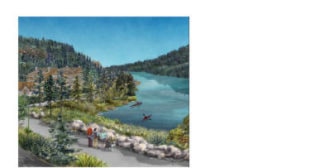Two public information meetings over two days were recently held in Nanoose Bay regarding Fairwinds’ application to amend the Official Community Plan (OCP) to develop in the Lakes District and Schooner Cove areas.
Both meetings had about 200 people in attendance, said Area E director and chair of the meeting George Holme. Yet, there were far more environmental concerns raised at the Lakes District meeting, he said.
“There were more at the first meeting ... oh yes,” he said. “They’ve got environmental concerns, and there are concerns there, there’s a lot of wetlands and stuff, so that will all be addressed.”
Holme’s own concern since the beginning has been over water, he said, stating Fairwinds would have to find a source.
“There’s no go without H20,” he said, adding the company is currently looking into it.
Annette Tanner, Wilderness Committee Mid Island co-ordinator was at the Lakes District meeting and said she thought it was extremely well run.
Tanner said neither the Fairwinds team nor the speakers dominated the meeting, and after a short presentation from Fairwinds about 25 speakers took to the microphone voicing well-researched concerns.
One of Tanner’s main issues she raised was regarding information Fairwinds passed out to the public in response to previous concerns discussing the CDF biogeoclimgimatic zone.
“They’ll need to go back to the drawing board and redefine what they stated about the Coastal Douglas Fir zone because it does not go up to Campbell River,” she said, saying instead it goes to Bowser.
Tanner credited the Fairwinds team with listening well throughout the meeting.
Another speaker at the meeting was Arrowsmith Parks and Land-Use Council (APLUC) member Christopher Stephens.
He stated the area represents one of the last remaining areas of the globally endangered CDF ecosystem, one of the four most endangered ecosystems in Canada. Stephens said the region is home to many special, range-restricted bird species which would be negatively impacted.
APLUC member Ronda Murdock said the Environmental Impact Assessment done by Fairwinds’ environmental consultants appeared to be based on incomplete and faulty biological inventory data in her presentation, something echoed by Nanoose resident and biologist Ross Peterson.
“I recommend that the RDN not consider this development proposal further until major errors and deficiencies in the environmental studies have been adequately addressed,” Peterson said, listing in detail where the deficiencies lie.
Holme noted about 40 per cent of presenters were not from the Nanoose Bay area, something that would have to be taken into account.
There were more Nanoose residents present at the Schooner Cove meeting on Tuesday however, Holme said. Some of the issues they raised included the proposed footpath on the breakwater, density and roads, he said. There were people who spoke in support of the development, he said.
The next step will involve RDN staff submitting the concerns raised at the meeting to Fairwinds. These would be addressed by Fairwinds at the next public hearing, Holme said.
The Neighbourhood Plans for Schooner Cove and the Lakes District were submitted to the RDN in May 2010, following a two year public consultation process by Fairwinds that included more than 50 meetings.
The proposal includes up to 395 condominium units in Schooner Cove and up to 1,675 homes in the Lakes District.
Details, including the proposed neighbourhood plan, technical reports, and the public consultation process to date can be viewed at: www.schoonercovelakesdistrict.ca.
